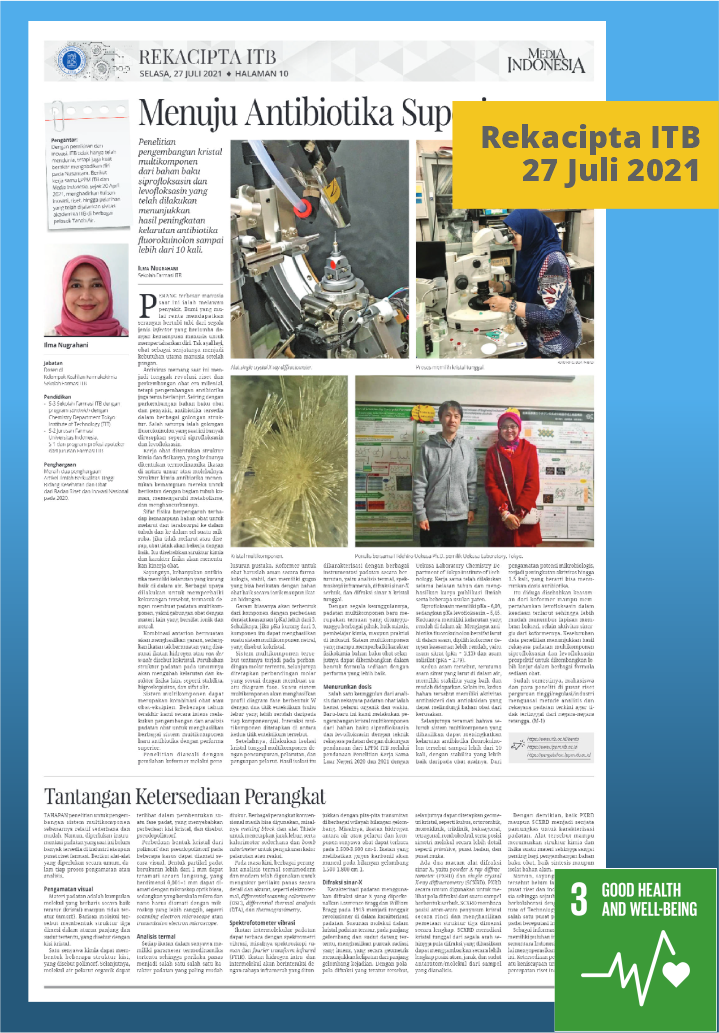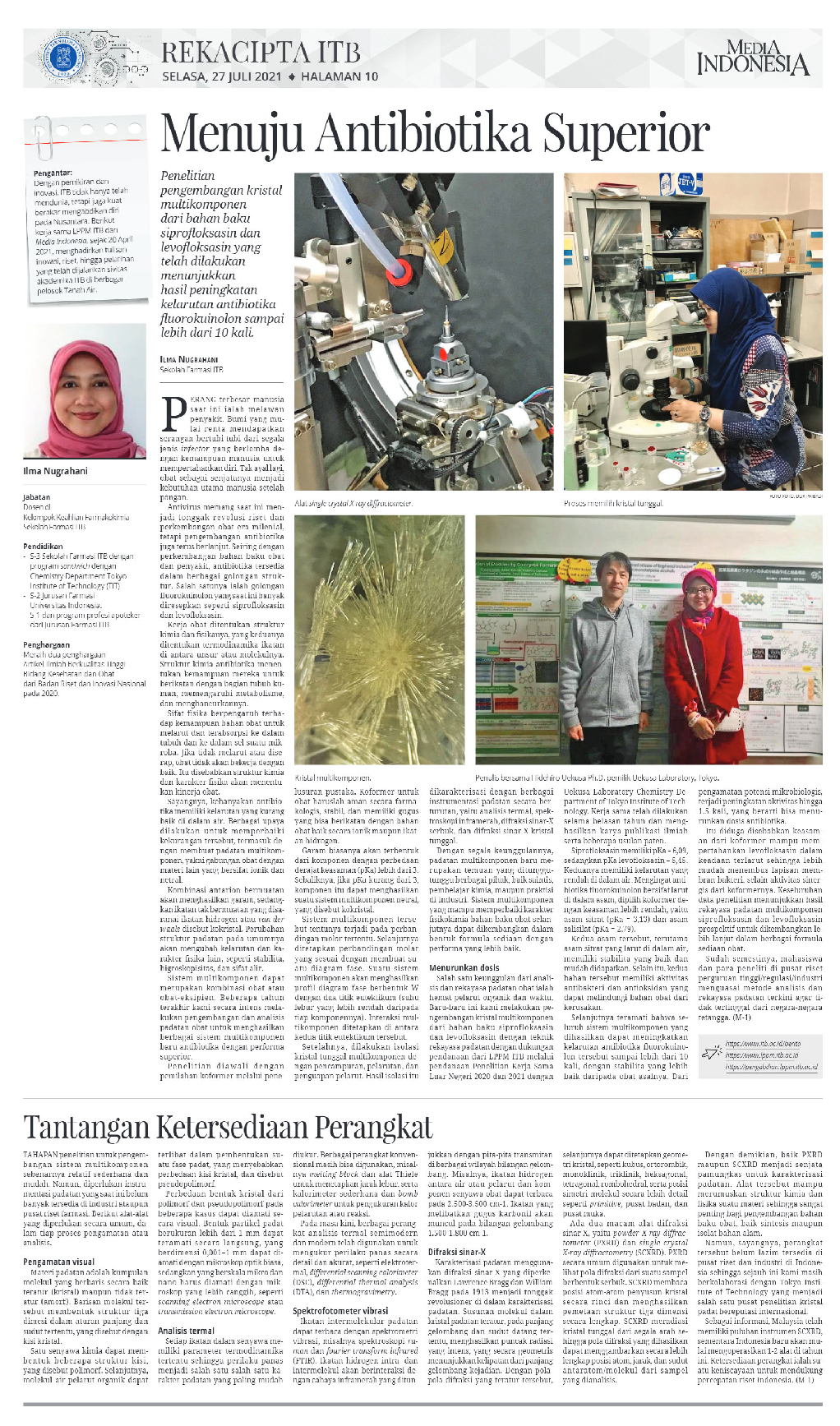

Towards Superior Antibiotics
Tags: ITB SDGs, Health, Human Immunodeficiency Virus , Healthy Lifestyle
Man's greatest war today is against disease. Earth that is starting to get old gets a barrage of attacks from all kinds of infectors who compete with humans' ability to defend themselves. No doubt, medicine as a weapon becomes a human need after food.
Antivirus is currently a milestone in the millennial era of drug research and development, but the development of antibiotics also continues. Along with the development of raw materials for drugs and diseases, antibiotics are available in various structural groups. One of them is the fluoroquinolone group which is currently widely prescribed such as ciprofloxacin and levofloxacin.
The action of a drug is determined by its chemical and physical structure, both of which are determined by the thermodynamics of the bonds between elements or molecules. The chemical structure of antibiotics determines their ability to bind to body parts of germs, affect their metabolism, and destroy them.
Physical properties affect the ability of the drug substance to dissolve and be absorbed into the body and into the cells of a microbe. If it is not dissolved or absorbed, the drug will not work properly. That is due to the chemical structure and physical character will find the performance of the drug.
Unfortunately, most antibiotics have poor solubility in water. Various efforts have been made to correct these deficiencies, including by making multicomponent solids, which are combinations of drugs with other materials that are ionic and neutral.
The combination of charged interions will produce salts, while the uncharged bonds are facilitated by hydrogen or van der bonds
walls are called cocrystals. Changes in the structure of solids in general, the structure of solids will generally change the solubility and other physical characteristics, such as stability, hygroscopicity, and flow properties.
Multicomponent systems can be drug or drug-excipient combinations. In recent years we have been intensively developing and analyzing drug solids to produce new multicomponent antibiotic systems with superior performance.
The research begins with sorting the coformers through a literature search. The general coformer of a drug must be pharmacologically safe, stable, and have a group that can bind to the drug substance either ionic or hydrogen bonds.
Salt will usually form from components with a difference in acidity (pKa) of more than 3. On the other hand, if the pKa is less than 3, the component can produce a neutral multicomponent system, called a cocrystal.
The multicomponent system certainly occurs at a certain molar ratio. Next, determine the appropriate molar ratio by constructing a phase diagram. A multicomponent system will produce a W-shaped phase diagram profile with two eutectic points (lower melting temperature than each component). A multicomponent interaction is established between the two eutectic points.
After that, the isolation of multicomponent single crystals was carried out by mixing, dissolving, and solvent evaporation. The results of the isolation were characterized by various solid instrumentation successively, namely thermal analysis, infrared spectroscopy, powder X-ray diffraction, and single crystal X-ray diffraction.
With all its advantages, the new multicomponent solid is a finding that has been eagerly awaited by various parties, both scientists, chemistry students, and practitioners in the industry. Multicomponent systems that are able to improve the physicochemical characteristics of medicinal raw materials can then be developed in the form of dosage formulas with better performance.
Reduces the Dose
One of the advantages of solid drug analysis and engineering is that it saves organic solvents and time. Recently, we developed multicomponent crystals from ciprofloxacin and levofloxacin raw materials with solid engineering techniques with funding support from LPPM ITB through 2020 and 2021 Foreign Cooperation Research funding with Uekusa Laboratory Chemistry Department of Tokyo Institute of Technology. The collaboration has been carried out for a dozen years and has resulted in scientific publications and several patent proposals.
Ciprofloxacin has a pKa: 6.09, while the pKa of levofloxacin: 5.45. Both have low solubility in water. Considering that fluoroquinolone antibiotics are acid soluble, coformers with lower acidity were chosen, namely citric acid (pKa : 3.13) and salicylic acid (pKa "'2.79).
Both of these acids, especially citric acid which is soluble in water, have good stability and are easy to obtain. In addition, both of these ingredients have antibacterial and antioxidant activities that can protect medicinal ingredients from damage.
It was further observed that the resulting whole multicomponent system could increase the solubility of the fluoroquinolone antibiotic by more than 10 times, with better stability than the original drug. From the observation of microbiological potential, there was an increase in activity up to 1.5 times, which means it could reduce the dose of antibiotics.
This is thought to be due to the acidity of the coformer able to maintain levofloxacin in a dissolved state so that it more easily penetrates the bacterial membrane layer, in addition to the synergistic activity of the coformer. Overall research data shows the engineering results of ciprofloxacin and levofloxacin multicomponent solids prospective to be further developed in various drug formulations.
As a matter of fact, students and researchers at research centers for universities/regulations/industry must master modern solids analysis and engineering methods so as not to lag behind neighboring countries. (M-1)

